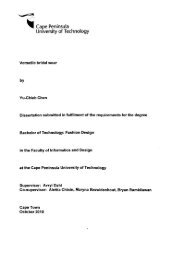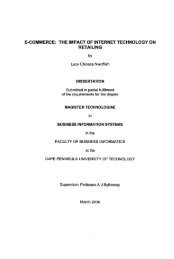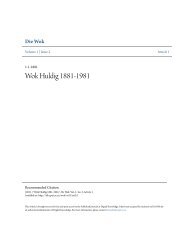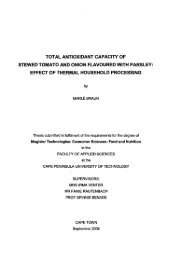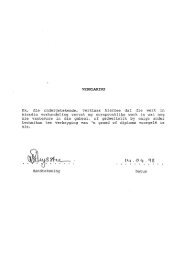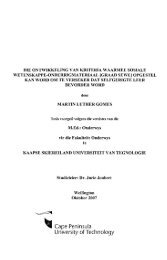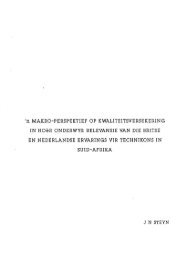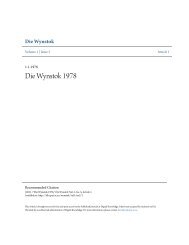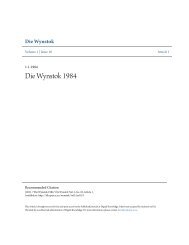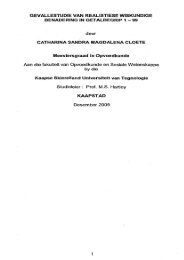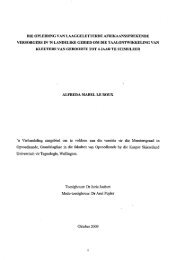the effect of the particle size distribution on non-newtonian turbulent ...
the effect of the particle size distribution on non-newtonian turbulent ...
the effect of the particle size distribution on non-newtonian turbulent ...
Create successful ePaper yourself
Turn your PDF publications into a flip-book with our unique Google optimized e-Paper software.
Chapter 5 Discussi<strong>on</strong> Page 5.4<br />
Whatever <str<strong>on</strong>g>the</str<strong>on</strong>g> point is at which <str<strong>on</strong>g>the</str<strong>on</strong>g> viscous sub-layer breaks down <str<strong>on</strong>g>the</str<strong>on</strong>g> fact still remains that<br />
<str<strong>on</strong>g>the</str<strong>on</strong>g> viscous sub-layer <str<strong>on</strong>g>of</str<strong>on</strong>g> a homogeneous slurry cannot exist if it is smaller than <str<strong>on</strong>g>the</str<strong>on</strong>g> <str<strong>on</strong>g>particle</str<strong>on</strong>g>s<br />
which comprise <str<strong>on</strong>g>the</str<strong>on</strong>g> slurry. As can be seen from Figure 4.18 (mixture 2) <str<strong>on</strong>g>the</str<strong>on</strong>g> viscous sub<br />
layer thickness is smaller than <str<strong>on</strong>g>the</str<strong>on</strong>g> <str<strong>on</strong>g>particle</str<strong>on</strong>g>s which comprise <str<strong>on</strong>g>the</str<strong>on</strong>g> slurry at higher waIl shear<br />
stresses. The thickness <str<strong>on</strong>g>of</str<strong>on</strong>g> <str<strong>on</strong>g>the</str<strong>on</strong>g> viscous sub-layer for kaolin clay (Figure 4.16) is smaller than<br />
<str<strong>on</strong>g>the</str<strong>on</strong>g> <str<strong>on</strong>g>particle</str<strong>on</strong>g>s which comprise <str<strong>on</strong>g>the</str<strong>on</strong>g> slurry at higher shear stresses but a much smaller fracti<strong>on</strong><br />
than mixture 2. At <str<strong>on</strong>g>the</str<strong>on</strong>g>se higher wall shear stress values <str<strong>on</strong>g>the</str<strong>on</strong>g> Slatter model best models <str<strong>on</strong>g>the</str<strong>on</strong>g><br />
test data for <str<strong>on</strong>g>the</str<strong>on</strong>g> kaolin clay and mixture 2 test sets. This could be ascribed to <str<strong>on</strong>g>the</str<strong>on</strong>g> fact that<br />
Slatter's model accounts for <str<strong>on</strong>g>the</str<strong>on</strong>g> <str<strong>on</strong>g>particle</str<strong>on</strong>g>s affecting <str<strong>on</strong>g>the</str<strong>on</strong>g> viscous sub-layer.<br />
To c<strong>on</strong>firm that <str<strong>on</strong>g>the</str<strong>on</strong>g> <str<strong>on</strong>g>particle</str<strong>on</strong>g>s will affect <str<strong>on</strong>g>the</str<strong>on</strong>g> viscous sub-layer and are relevant for <strong>turbulent</strong><br />
flow analysis <str<strong>on</strong>g>the</str<strong>on</strong>g> number c<strong>on</strong>centrati<strong>on</strong> <str<strong>on</strong>g>of</str<strong>on</strong>g> large <str<strong>on</strong>g>particle</str<strong>on</strong>g>s in <str<strong>on</strong>g>the</str<strong>on</strong>g> viscous sub-layer was<br />
calculated. In order to calculate <str<strong>on</strong>g>the</str<strong>on</strong>g> number c<strong>on</strong>centrati<strong>on</strong> a few assumpti<strong>on</strong>s had to made.<br />
The assumpti<strong>on</strong>s were as follows:<br />
• <str<strong>on</strong>g>the</str<strong>on</strong>g> <str<strong>on</strong>g>particle</str<strong>on</strong>g>s comprising <str<strong>on</strong>g>the</str<strong>on</strong>g> slurry are spherical in shape;<br />
• <str<strong>on</strong>g>the</str<strong>on</strong>g> large <str<strong>on</strong>g>particle</str<strong>on</strong>g>s were taken to be greater than <strong>on</strong>e half <str<strong>on</strong>g>of</str<strong>on</strong>g> <str<strong>on</strong>g>the</str<strong>on</strong>g> thickness <str<strong>on</strong>g>of</str<strong>on</strong>g> <str<strong>on</strong>g>the</str<strong>on</strong>g><br />
viscous sub-layer in <strong>turbulent</strong> flow;<br />
• <strong>on</strong>e metre <str<strong>on</strong>g>of</str<strong>on</strong>g> pipe tubing was c<strong>on</strong>sidered for calculati<strong>on</strong>s;<br />
• an average radius is assumed for <str<strong>on</strong>g>the</str<strong>on</strong>g>" large <str<strong>on</strong>g>particle</str<strong>on</strong>g>s.<br />
From Figure 4.16 to Figure 4.18 we can determine <str<strong>on</strong>g>the</str<strong>on</strong>g> thickness <str<strong>on</strong>g>of</str<strong>on</strong>g> <str<strong>on</strong>g>the</str<strong>on</strong>g> viscous sub-layer in<br />
<strong>turbulent</strong> flow. The thickness <str<strong>on</strong>g>of</str<strong>on</strong>g><str<strong>on</strong>g>the</str<strong>on</strong>g> viscous sub-layer for kaolin clay, mixture 1 and mixture<br />
2 is approximately 40JLm, 300JLm and 55JLm respectively. The percentage <str<strong>on</strong>g>of</str<strong>on</strong>g> large <str<strong>on</strong>g>particle</str<strong>on</strong>g>s<br />
present in <str<strong>on</strong>g>the</str<strong>on</strong>g> viscous sub-layer can <str<strong>on</strong>g>the</str<strong>on</strong>g>refore be determined from <str<strong>on</strong>g>the</str<strong>on</strong>g> PSD (ie. percentage<br />
<str<strong>on</strong>g>of</str<strong>on</strong>g> Particles greater than <strong>on</strong>e half <str<strong>on</strong>g>the</str<strong>on</strong>g> viscous sub-layer thickness). From <str<strong>on</strong>g>the</str<strong>on</strong>g> diameter and<br />
Viscous SUb-layer thickness <str<strong>on</strong>g>the</str<strong>on</strong>g> volume <str<strong>on</strong>g>of</str<strong>on</strong>g> <str<strong>on</strong>g>the</str<strong>on</strong>g> viscous sub-layer can be determined and<br />
knOWing <str<strong>on</strong>g>the</str<strong>on</strong>g> percentage <str<strong>on</strong>g>of</str<strong>on</strong>g> large <str<strong>on</strong>g>particle</str<strong>on</strong>g>s <str<strong>on</strong>g>the</str<strong>on</strong>g> volume taken up by <str<strong>on</strong>g>the</str<strong>on</strong>g> <str<strong>on</strong>g>particle</str<strong>on</strong>g>s in <str<strong>on</strong>g>the</str<strong>on</strong>g> viscous<br />
Sub-layer can be calculated. The mass <str<strong>on</strong>g>of</str<strong>on</strong>g> <str<strong>on</strong>g>particle</str<strong>on</strong>g>s can be obtained from <str<strong>on</strong>g>the</str<strong>on</strong>g> volume and<br />
jensityand similarly by c<strong>on</strong>sidering <strong>on</strong>e <str<strong>on</strong>g>particle</str<strong>on</strong>g> present in <str<strong>on</strong>g>the</str<strong>on</strong>g> viscous sub-layer, it's mass<br />
:an be calculated and hence <str<strong>on</strong>g>the</str<strong>on</strong>g> number <str<strong>on</strong>g>of</str<strong>on</strong>g> <str<strong>on</strong>g>particle</str<strong>on</strong>g>s. The results obtained are shown in



